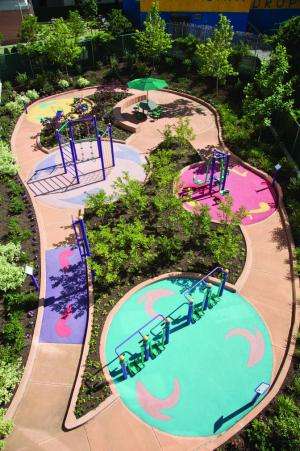Good design improves health by fostering physical activity

Active Design: Affordable Designs for Affordable Housing is a new report that builds on the Active Design Guidelines published by New York City in 2010. The report examines strategies and costs for incorporating active design principles specifically aimed at increasing physical activity among children ages 3 to 18 years old in family-focused affordable housing developments. The strategies included in the report are based on evaluation of urban and suburban affordable housing developments across three cities: New York, New York; San Antonio, Texas; and Atlanta, Georgia.
"It is remarkable how easy and affordable it is to incorporate active design elements into multi-family housing development," said Jennifer DuBose, a Georgia Tech research scientist. "We believe that the detailed examples and cost information provided in the report give developers practical information that they can use immediately to promote active lifestyles."
"Affordable Designs for Affordable Housing aims to provide professionals designing and developing affordable housing with low-cost solutions for increasing physical activity in their developments through design," said Gayle Nicoll, dean of design at the Ontario College of Art and Design University in Toronto, Canada, who co-authored the study.
"When implemented, the low-cost and cost-neutral strategies presented in the document will support physical activity and better health," said Karen K. Lee of the Built Environment and Healthy Housing Program at the New York City Department of Health and Mental Hygiene, another co-author of the study. "The document provides opportunities for housing authorities, developers and designers to build housing units that support healthier living for the children and families living in their communities. This, in turn, is critical in helping us address the key epidemics of our time, such as obesity."
Children in America, especially those from low-income populations, are disproportionately affected by health problems, including those related to obesity. There is strong evidence that physical activity is a key part of achieving and maintaining good health and that the physical environment of homes and neighborhoods influences physical activity and thereby obesity rates. Low-income neighborhoods are generally less supportive of physical activity than higher income neighborhoods, putting residents at a disadvantage health-wise.
The designers re-envisioned each project with the objective of increasing opportunities for physical activity among children in a cost-effective way. A cost estimate is provided for each of the suggested changes based on cost data reference guides and historical data.
"Your recommendations provide a toolbox for all housing developers to help create healthy communities that encourage physical activity for residents of all ages," said Trish O'Connell, vice president of real estate development and acquisitions at the Atlanta Housing Authority. "The real-world examples and cost data reference guides are extremely helpful and provide the kind of information that developers will use when planning their communities."
Affordable design affordable housing recommendations
Low-cost and immediately implementable strategies:
- Provide stair prompt signage at points of decision, such as elevator call areas and outside stairwells, to encourage stair use.
- Co-locate adult physical activities near child activities to encourage physical activity as a family value.
- Provide secure bicycle storage.
- Provide low-cost interventions such as playground markings to encourage active play.
- Provide information boards about local physical activity opportunities.
Strategies implementable in future developments with no cost or only minor cost:
- Make stairs more visible and accessible.
- Provide safe, visible and more direct paths linking shared common spaces such as lobbies and residential units to physical activity facilities.
- Judiciously program outdoor spaces to accommodate physical activity opportunities without encroaching upon quiet programmed spaces.
- Provide safe and positive recreational activities for young children, adolescents and teenagers.
- Address climatic restrictions on physical activity within the development.
More challenging strategies, but still possible if supported by market expectations and financial analysis:
- Expand indoor and onsite outdoor facilities to accommodate diverse activities for children ages 3 to 18.
- Negotiate expenditures of development fees with municipal authorities to support nearby public physical activity facilities.
More information:
Active Design Guidelines
Link to full Affordable Design for Affordable Housing Supplement














